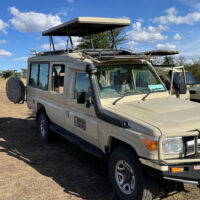Cameras of Kilimanjaro: See the mountain from the porters’ perspective
12.16.2010

Kilimanjaro has a few dirty little secrets. We’ve talked before about one of them—that the most popular routes can be absurdly crowded.
A far darker secret no on likes to talk about is that many porters aren’t paid livable wages, often have to pay for their own food on the way up and therefore barely eat anything while hauling backbreaking loads, and refuse to turn back down the mountain when they experience altitude sickness because they cannot afford to.
So it is with great pride that we at Embark are a part of the great Kilimanjaro Porters Assistance Project, the nonprofit that focuses on ensuring that porters make livable wages, are treated fairly, and that they actually receive the tips climbers try to give them.
We sat down this week to Skype with Australia-based photographer Helen Osler, who became involved with the porters project when she climbed the mountain back in 2008. She tells us one thing that really struck her about the porters that helped her reach the summit was how interested they were in her camera, and how skilled so many of them were as photographers.
She began to wonder how she could get porters on the mountain to take photos, given they couldn’t afford the equipment. So she launched the Porters of Kilimanjaro Photographic Project, through which she had people all around the world who were traveling to Tanzania bring disposable cameras and then get them back to her weeks later.
Out of the 75 cameras delivered to Mt. Kilimanjaro, 55 came back, giving Helen more than 1,000 photos to sift through. She says she was struck by how thoughtful so many of the images are, and was inspired to develop a book, even though the resolution isn’t large enough for a truly large, coffee-table, glossy book.
Called Cameras of Kilimanjaro, the 104-page color book costs roughly $48, but money raised through the photographic project will be used to improve the porters’ working conditions. Helen’s drive to help the porters is truly admirable. Among her observations:
“There are incredible risks, the same as everyone who climbs there, yet they can’t afford to go down. Their families won’t be eating if they lose their job that day, so they keep going. When I climbed, we gave medication to two or three of the porters, but they refused to go down. And there was nothing we could do about that; it was their choice.”
Helen says the average wage each porter earns per day should be 8,000 Tanzanian shillings, but the porters association has found it goes as low as 6,000. This converts to $4 a day instead of $5, “which is well under what they should be paid,” Helen says. “Which in our terms is just nothing.”
Check out the book, and if you can’t afford it, spread the word about it and about the Kilimanjaro Porters Assistance Project, too. But the best thing you can do if you’re going to climb Kilimanjaro is to make sure that you find an outfit that works with the project and to do what you can to deliver tips to porters yourself. And remember: When you pay as little as possible to climb, the porters are the first to take that hit.



